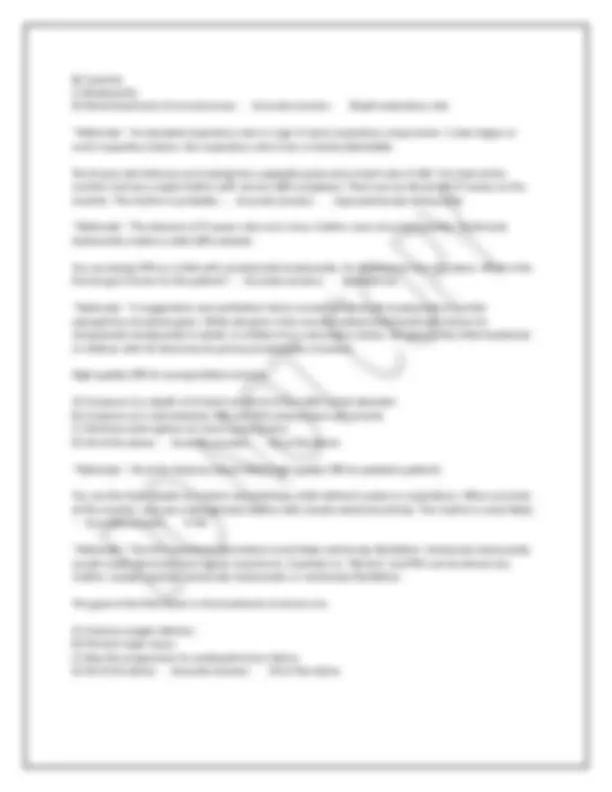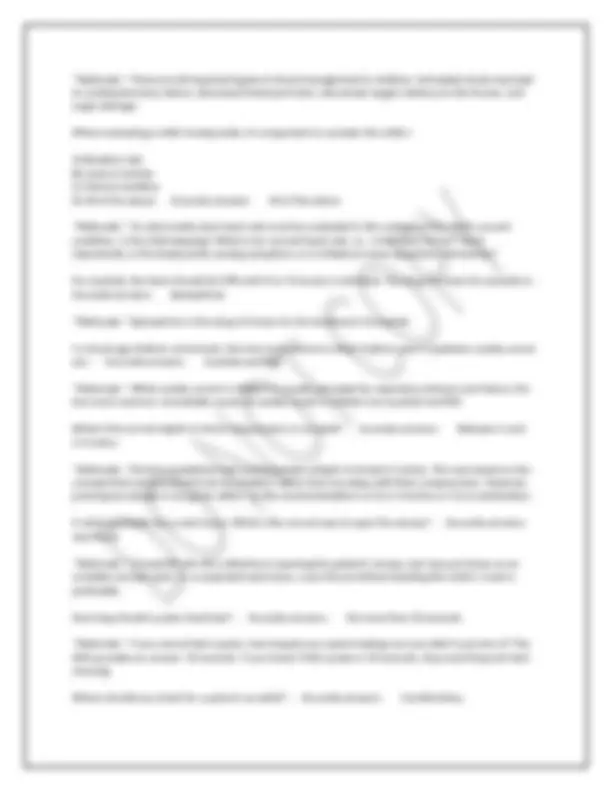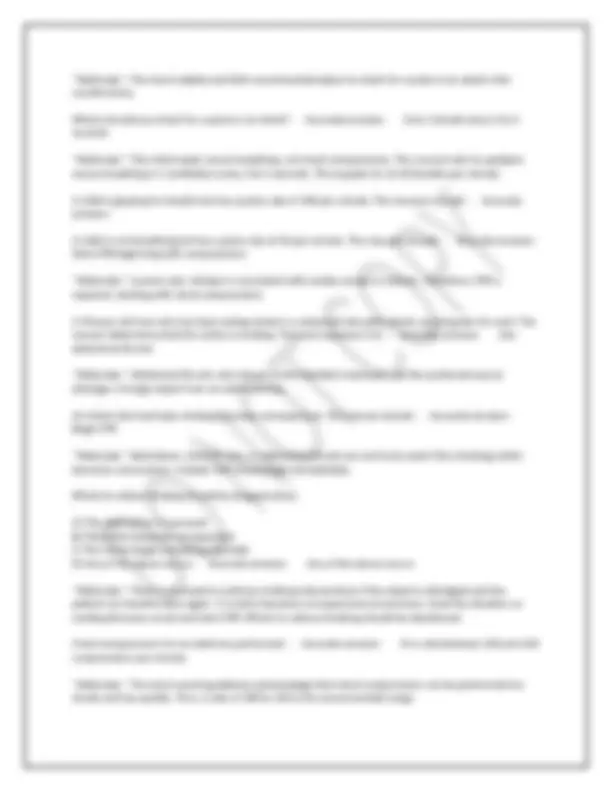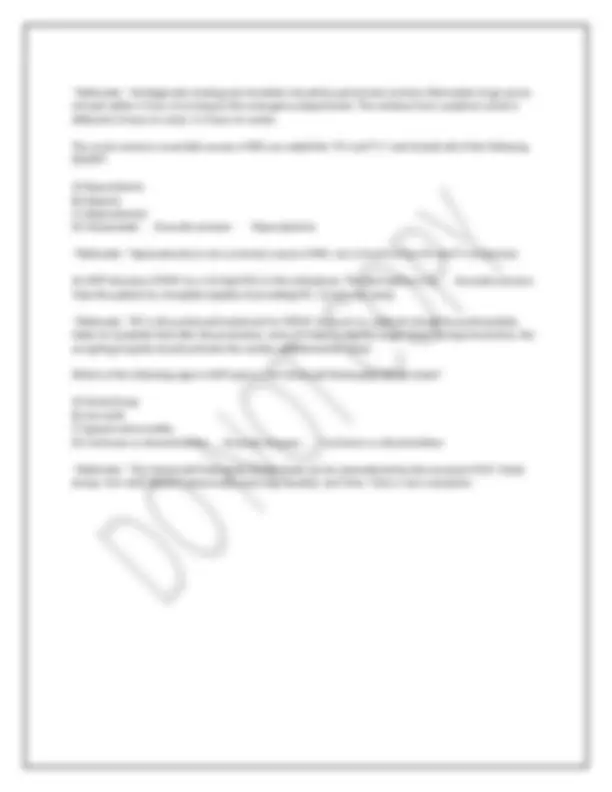






Study with the several resources on Docsity

Earn points by helping other students or get them with a premium plan


Prepare for your exams
Study with the several resources on Docsity

Earn points to download
Earn points by helping other students or get them with a premium plan
Community
Ask the community for help and clear up your study doubts
Discover the best universities in your country according to Docsity users
Free resources
Download our free guides on studying techniques, anxiety management strategies, and thesis advice from Docsity tutors
ACLS TEST PREP (PALS, BLS, ACLS) QUESTIONS WITH 100% ACCURATE ANSWERS
Typology: Exams
1 / 8

This page cannot be seen from the preview
Don't miss anything!





These 50 questions and answers are found on. You can take the test there is you would rather study in a test format. You could also us the test study feature on quizlet. Hope this helps you study some basic ACLS. - Accurate answers https://www.aclsmedicaltraining.com/practice-tests/ A 5-year-old child in supraventricular tachycardia has adequate pulses with the rhythm. Supplemental oxygen is in place and vital signs are stable except for the elevated heart rate. The most appropriate next intervention for this child is: - Accurate answers Vagal Maneuvers Rationale: Vagal maneuvers are a reasonable first intervention for supraventricular tachycardia in a hemodynamically stable patient, as this child is. A child has an advanced airway in place during cardiac arrest. How frequently should ventilations be given? - Accurate answers Every 6-8 Seconds 8-10 BPM Rationale: The latest AHA guidelines recommend one ventilation every six seconds, or 10 per minute, when an advanced airway is in place. You are using a bag-valve mask to resuscitate an infant, while another rescuer is performing chest compressions. What is the correct ratio of chest compressions to ventilations? - Accurate answers 15 chest compressions to 2 ventilations Rationale: The AHA suggests that during a pediatric resuscitation with two or more rescuers present, the correct ratio of chest compressions to ventilations is 15:2. You are alone performing infant CPR. What is the correct ratio of chest compressions to ventilations? - Accurate answers 30 chest compressions to 2 ventilations Rationale: The AHA suggests that during a pediatric resuscitation with only one rescuer present, the correct ratio of chest compressions to ventilations is 30:2. A 7 month old appears to be unconscious and not breathing. You check for a pulse at the ________ artery. - Accurate answers Brachial Rationale: Rescuers should use the brachial artery in the upper arm to check for a pulse. The artery is easily palpable in infants and young children. A clear sign of upper airway obstruction is: - Accurate answers A "whistling" sound during breathing
Rationale: A "whistling" sound during breathing usually indicates stridor. Crying suggests full lung function, as does breath sounds in all lung fields. Decreased inspiratory effort is a non-specific sign, but may reflect a central process (i.e. consequence of head trauma). In children, which of the following is the most common form of arrest? - Accurate answers Respiratory arrest Rationale: Respiratory distress, failure, and arrest are the most common conditions prompting PALS care. In fact, most cases of pediatric cardiac arrest are preceded by respiratory issues. In small children, a rescue breath should be given: - Accurate answers Over one second Rationale: Rescue breaths and ventilations should be delivered over one second, regardless of the patient's age. What is the normal range of heart rates for an 8-year-old child? - Accurate answers Answer: 60- 140 per minute (The ACLS test I took says this. This is most likely a older ACLS test. According to 2015 Handbook of Emergency Cardiovascular Care it says for a school-age child the rate is 75-118.) Rationale: Normal vital sign values change as children age. It is important to know what "normal" is for the age of your patient. The child you are caring for is very pale. You know that this pallor can be caused by all of the following EXCEPT: A) Anemia B) Heat C) Shock D) Albinism - Accurate answers Heat Rationale: Heat generally causes skin flushing and capillary dilation, which makes the skin red/pink. The other conditions result in pale skin. Anemia and shock are due to decreased blood flow through skin capillaries. Albinism is due to a congenital lack of skin pigment. Clinical signs of respiratory distress may include all of the following EXCEPT: A) Rapid respiratory rate B) Grunting respirations C) Warm, pink skin D) Diminished level of consciousness - Accurate answers Warm, pink skin Rationale: Grunting respirations, rapid respiratory rate, and a diminished level of consciousness are signs of respiratory compromise. Warm, pink skin would not normally occur during the course of respiratory distress. Late and ominous signs of respiratory failure include all of the following EXCEPT: A) Rapid respiratory rate
Rationale: These are all important goals of shock management in children. Untreated shock may lead to cardiopulmonary failure, decreased blood perfusion, decreased oxygen delivery to the tissues, and organ damage. When evaluating a child's bradycardia, it is important to consider the child's: A) Baseline rate B) Level of activity C) Clinical condition D) All of the above - Accurate answers All of the above Rationale: An abnormally slow heart rate must be evaluated in the context of the child's current condition. Is the child sleeping? What is her normal heart rate, i.e., is this slow for her? Most importantly, is the bradycardia causing symptoms or is it likely to cause symptoms imminently? For asystole, the team should do CPR until IV or IO access is achieved. The drug of choice for asystole is: - Accurate answers Epinephrine Rationale: Epinephrine is the drug of choice for the treatment of asystole. In school age children and infants, the two most common initial rhythms seen in pediatric cardiac arrest are: - Accurate answers Asystole and PEA Rationale: While cardiac arrest in children is usually preceded by respiratory distress and failure, the two most common, immediate causes of cardiac arrest in children are asystole and PEA. What is the correct depth of chest compressions in an adult? - Accurate answers Between 2 and 2.4 inches Rationale: Previous guidelines had recommended a depth of at least 2 inches. This was based on the concept that rescuers tend to be too shallow, rather than too deep with their compressions. However, pressing too deeply is not good, either. So the recommendation is 2 to 2.4 inches or 5 to 6 centimeters. A victim probably has a neck injury. What is the correct way to open the airway? - Accurate answers Jaw thrust Rationale: A head tilt-chin lift is effective in opening the patient's airway, but may put stress on an unstable cervical spine. In a suspected neck injury, a jaw thrust without bending the victim's neck is preferable. How long should a pulse check last? - Accurate answers No more than 10 seconds Rationale: If you cannot feel a pulse, how long do you spend making sure you didn't just miss it? The AHA provides an answer: 10 seconds. If you haven't felt a pulse in 10 seconds, stop searching and start rescuing. Where should you check for a pulse in an adult? - Accurate answers Carotid artery
Rationale: The most reliable and AHA-recommended place to check for a pulse in an adult is the carotid artery. Where should you check for a pulse in an infant? - Accurate answers Give 1 breath every 3 to 5 seconds Rationale: This child needs rescue breathing, not chest compressions. The correct rate for pediatric rescue breathing is 1 ventilation every 3 to 5 seconds. This equates to 12-20 breaths per minute. A child is gasping for breath but has a pulse rate of 100 per minute. The rescuers should: - Accurate answers A child is not breathing but has a pulse rate of 50 per minute. The rescuers should: - Accurate answers Start CPR beginning with compressions Rationale: A pulse rate <60 bpm is consistent with cardiac arrest in children. Therefore, CPR is required, starting with chest compressions. A 50-year-old man who has been eating steak in a restaurant abruptly stands up and grabs his neck. The rescuer determines that the victim is choking. The best response is to: - Accurate answers Use abdominal thrusts Rationale: Abdominal thrusts, also known as the Heimlich maneuver, are the preferred way to dislodge a foreign object from an adult's airway. An infant who had been choking becomes unresponsive. The rescuer should: - Accurate answers Begin CPR Rationale: Back blows, chest thrusts, or abdominal thrusts are not to be used if the chocking victim becomes unconscious. Instead, CPR should begin immediately. Efforts to relieve choking should be stopped when: A) The obstruction is removed B) The victim becomes unresponsive C) The victim begins breathing normally D) Any of the above occurs - Accurate answers Any of the above occurs Rationale: There is no need to continue choking interventions if the object is dislodged and the patient can breathe once again. If a victim becomes unresponsive/unconscious, treat the situation as cardiopulmonary arrest and start CPR. Efforts to relieve chocking should be abandoned. Chest compressions for an adult are performed: - Accurate answers At a rate between 100 and 120 compressions per minute. Rationale: The most recent guidelines acknowledge that chest compressions can be performed too slowly and too quickly. Thus, a rate of 100 to 120 is the recommended range.
Rationale: The main drug treatment for narrow QRS complex SVT is adenosine. The other drugs are used in ACLS under different circumstances. Pulseless electrical activity is treated with _______? - Accurate answers Epinephrine Rationale: Epinephrine is the standard treatment for PEA. Unsynchronized cardioversion is not recommended because PEA is not considered a "shockable" rhythm. The correct sequence for basic life support is: - Accurate answers CAB - Compressions, Airway, Breathing. Rationale: While ABC is easier to remember, the proper sequence for basic life support is now CAB; Compressions (circulation), Airway, Breathing. Which of the following is the correct initial dose of adenosine for the treatment of supraventricular tachycardia? - Accurate answers 6 mg IV Rationale: The first dosage of adenosine is 6 mg IV. If 6 mg fails to achieve an effect, the subsequent dosage is 12 mg IV. At what heart rate does tachycardia usually become symptomatic? - Accurate answers 150 BPM Rationale: While it depends on the patient, a useful rule of thumb is tachycardia starts to become symptomatic at 150 bpm. The textbook definition of tachycardia is a heart rate >100 bpm. Sinus bradycardia Rationale: There is a P wave at an appropriate length of time before a normal QRS complex during each heartbeat. The only apparent anomaly is that the rate is very slow. - Accurate answers You are the paramedic on an ambulance transporting a 65-year-old female. The patient is connected to the monitor and you see this rhythm; she has a palpable pulse. What is the rhythm? True or False: Pulse checks should be done for at least 10 seconds. - Accurate answers False Rationale: They should be done for no more than 10 seconds. True or False: The initial recommended dosage of atropine for symptomatic bradycardia is 0.5 mg IV. - Accurate answers True Rationale: Dosages less than 0.5 mg may cause a paradoxical slowing of the heart rate. During cardiopulmonary resuscitation, deliver oxygen at: - Accurate answers 100% Rationale: CPR is performed during cardiac arrest and 100% oxygen should be administered during cardiac arrest. The goal for initiation of fibrinolytic therapy in appropriate stroke patients is: - Accurate answers Within 1 hour of arrival to the ED.
Rationale: All diagnostic testing and checklists should be performed so that a fibrinolytic drug can be infused within 1 hour of arriving to the emergency department. The window from symptom onset is different (3 hours in most, 4.5 hours in some). The most common reversible causes of PEA are called the "H's and T's" and include all of the following EXCEPT: A) Hypovolemia B) Hypoxia C) Hypocalcemia D) Tamponade - Accurate answers Hypocalcemia Rationale: Hypocalcemia is not a common cause of PEA, nor is it part of the H's and T's mnemonic. An EMT discovers STEMI on a 12-lead ECG in the ambulance. The best option is to: - Accurate answers Take the patient to a hospital capable of providing PCI, 15 minutes away. Rationale: PCI is the preferred treatment for STEMI. So much so, patients should be preferentially taken to hospitals that offer the procedure, even if it takes a slightly longer time. During travel time, the accepting hospital should activate the cardiac catheterization team. Which of the following signs is NOT part of the Cincinnati Prehospital Stroke Scale? A) Facial droop B) Arm drift C) Speech abnormality D) Confusion or disorientation - Accurate answers Confusion or disorientation Rationale: The Cincinnati Prehospital Stroke Scale can be remembered by the acronym FAST: Facial droop, Arm drift, Speech abnormality (slurring, usually), and Time. Time is not a symptom.